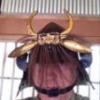-
Posts
14,189 -
Joined
-
Last visited
-
Days Won
266
Content Type
Profiles
Forums
Events
Store
Downloads
Gallery
Everything posted by Bugyotsuji
-
This first is one of the seven gods of wealth and good fortune, Daikoku-Ten or Daikoku, with his magic hammer. A crude but genuine still-intact Edo-period Netsuke. View of Uchide-no-Kozuchi hammer
-
Thinking now that I might just clear out this ceramic Netsuke angle by posting a couple more that I found at home recently. Watch this space. In the meantime, Pietro has kindly contacted me and pointed out this excellent visual link to the book on the above-mentioned Silverman collection. Thank you! https://archive.org/details/adornmentinclayc00laur He has also included a link to FaceBook where former collectors from the International Netsuke Society's virtually defunct internet forum now gather. Since I became allergic to F/B many years ago I am missing out by not visiting there. If anyone Facebook-oriented is interested in a serious scholarly group though, please visit there. https://www.facebook.com/groups/netsukes
-
You are right to ask this question, Alexander. May I counter with why you wish to buy over internet auction images? Personally I find myself drawn more to parts of the second example, even if it is not composite.
-
OK, those are great. Thanks Mike. The pan lid (hinged cover) and pin are non-standard but I guess they would perform the role just fine. Nice fluted barrel. I’m thinking somewhere geographically non-mainstream, but without my reference books here I cannot yet pin it down in my mind.
-
There’s a Japanese expression, ‘Oni ni kanabō’ 鬼に鉄棒 Giving a metal club to an ogre means further enabling someone already fearful.
-
松竹梅 Shō-Chiku-Bai, the three symbolizing New Year. (Not sure where they got ‘Masa’ from!) Different museum staff recording at different times. Dale, you could be hired and passed around from institution to institution!
-
Hi Shaun, the scene looks more Japanese than Chinese. Is there a signature at the bottom right? PS Where are those photos stored? There are several easy ways to downsize photos, including using the menu inside your phone camera.
-
The bore is 0.59" which is 1.49 cm, around 5 Monme, originally an army long gun. Many of the crudely scratched numbers will have been notations for the workshop artisans. Can you get overall shots Mike of the gun from the right side and the left side? Might help narrow down where it was made? An angled shot into the pan with vent hole visible might be good too. Do you know exacty where that Yama 山 kanji is located? The underside of the barrel is smooth otherwise?
-
The barrel decorations were probably all added in Meiji, after the end of the Edo Period. It was common then to add a Tokugawa Mon in brass like that, and the single character is likely the ‘Kao’ of the inlay artist. There is a single upside-down 山 Kanji character which means mountain but makes no sense there on its own. Nothing else written under the barrel? There are crudely scratched numbers 二十六 (26) which may be an order run number. The serpentine and lock plate look good. The pan cover is probably a replacement, as too the amaooi rain guard. The priming pan looks a little messed up. Were you able to open the large bisen breech screw? There are various other comments one could make, but some of the most important parts are not visible in those photos. A good study piece!
-

Attempting to roughly ballpark age on a rescued wakizashi
Bugyotsuji replied to NotANinja's topic in Nihonto
There were two Bizen Norimitsu in that time period, with different characters, one 則光 and this one 宝光, but maybe it is 重光Shigemitsu? -
Not able to get everything, sadly, but 関住白口貞弘作, where 口 = a kanji I cannot read. Assuming that it is a place name in the Seki area that begins with 白... (?) Or 白鵜, a play on the sound of his name 四郎? Shi-ro-u Giving up for now.
-
The Horyu paperwork clearly says there is a last kanji in the date, but that they cannot read it, using an open mouth box to indicate this i.e. 徳治三+口 I have found in the past that experimentation with different lighting conditions can (faintly) bring up a character that shinsa teams do not have the time to properly investigate. Certainly with just one dark photograph of your nakago, we here do not have a chance, but you, with time and patience, might. .
-
Thank you Moriyama Sama for Nebiki-matsu, that is the word I was looking for! (Shown also in Dale's guard with the roots encased as Kadomatsu).
-
吉日 it’s formulaic but 吉 = lucky/auspicious + 日= day
-
Sotetsu were given to Okayama and planted at the temple to Ukita Hideie, so it could symbolize this gift from Hachijo-jima. Another possibility is the New Year's kadomatsu ceremony where a whole baby pine was used, with roots. Some pine branch outlines and needles look quite similar.
-
Try ‘sotetsu’ Damon, and the story of the Ukita being banished for centuries to Hachijojima Island.
-
Agreed, but why do dealers use such fuzzy photos?
-

Edo Period Corner Part II
Bugyotsuji replied to estcrh's topic in General Nihonto Related Discussion
https://travel.gaijinpot.com/bizen-osafune-sword-museum/ General background information -
Ken katabami, Ukita. The large Ukita contingent (who lost as part of the western forces at the Battle of Sekigahara in 1600) would surely have lost credibility post battle and become homeless ronin.
-

Council
Bugyotsuji replied to Pritajeni1's topic in Sword Shows, Events, Community News and Legislation Issues
The certificate is Chinese. -
Ken-katabami, = Katabami flower with ken blades. 剣片喰
-
This was a seminal book Jan. Hoping the new one can come to fruition!
-

Early Japanese firearm related images and information.
Bugyotsuji replied to estcrh's topic in Tanegashima / Teppo / Hinawajū
Trying to sleep as I must be up at 4:00. Can’t believe how many people have chosen today of all days to get in contact! The two on the left are in the museum in Tanegashima. The top one may be an original barrel, but it was in a fire and rebuilt in Meiji. The bottom one looks to be a sort of copy maybe from mid-Edo.










